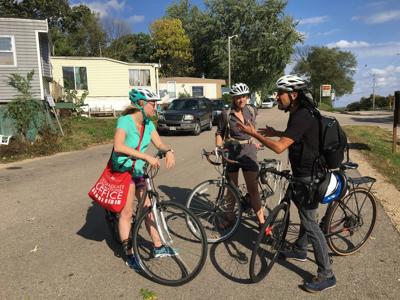Baltazar De Anda-Santana straddled his bike outside Centro Hispano on Badger Road, explaining to the white bike riders with him how challenging it is to get to the popular Latino community service provider.
“If the folks who live in the Monroe area or the Atwood area lived around here, I think that it would be a different story,” he said of the well-heeled neighborhoods on the west and east sides.
De Anda-Santana, a program coordinator for the Wisconsin Bike Federation, is on a mission to make biking safe for undocumented and other minority residents who live outside Madison’s vast network of bike paths, trails and designated bike lanes. To raise awareness of the issue, he offered a tour Wednesday following the YWCA Racial Justice Summit of the precarious routes that connect many minority neighborhoods to jobs in the downtown area.
Two people and a reporter took him up on it.
Setting off from Monona Terrace Convention Center on the teeming Capital City bike path, then the bike path through Brittingham Park, De Anda-Santana led the group onto Park Street where the bike lane appears, then for a stretch disappears as rush-hour traffic speeds by.
At Badger Road, he turned off to Centro Hispano, which is fronted by a busy road with no bike lanes. A new bike maintenance station with a rack and a pump sits ironically at the corner of the building.
It’s a dicey ride, he said, especially for unseasoned riders. It would likely be easier, he said, if Centro Hispano was in one of those neighborhoods “that have a little bit more money”
“One of the things that we see in the downtown, we try to make biking comfortable,” he said. “On the south side and the north side, it’s not even safe.”
Down Badger Road, he takes the group to a trailer park overlooking the Beltline. Two weeks ago that same trailer park was targeted in immigration raids. Many of the residents, De Anda-Santana said, have to get to jobs downtown or further down Park Street, a harrowing ride for unseasoned bikers.
“If you live on the south side and the dad doesn’t have a driver’s license, the dad needs to be able to bike from his home to downtown, and the only direct route is through Park Street,” he said.
De Anda-Santana said the lack of easy bike access to downtown from the south side demonstrates how the city’s expanding bike network is bypassing poor areas, where biking is not a choice, but a necessity. Many low-income residents can’t afford cars, and many don’t have valid driver’s licenses.
Advocates have been pushing for a direct off-road route downtown from the north side for years.
Meanwhile, the city recently spent millions beefing up the bike network on the west side and three years ago became one of only five cities to earn platinum status from the League of American Bicyclists.
“We’re a good city when it comes to biking, but just for some members of our community,” he said. “Specifically the white members of our community, the privileged members of our community.”
Some of the problem, he admits, is cultural.
“In Mexico, if you don’t have a car you’re poor,” he said. “In Madison, if you don’t have a car you’re cool. When our communities come to this country, they say, ‘I don’t want to bike. If I bike it’s a reminder that I am poor.’”
De Anda-Santana and others are trying to change that. An $84,200 grant from the Madison Community Foundation to Just Bikes, a coalition of area bicycling advocacy groups, allowed for a 1,100-bicycle giveaway, mostly to kids on the north and south sides, as well as a bike repair vehicle, five bike repair stations like the one at Centro Hispano, and repair training.
One important aspect of making biking safe in low-income communities, De Anda-Santana said, is education. He said he’s seen people making their way downtown on bikes that are in “terrible condition,” at night with no lights, and not wearing weather appropriate clothing in winter.
As a Bike Fed ambassador, he works with people to find safe routes, including work with Madison’s Safe Routes to School program. He said he’s also working on other initiatives to bring safe biking practices and advocacy to neighborhoods.
But getting the city to invest in infrastructure in low-income areas poses its own set of challenges, especially when the people living there, because of their immigration status, are afraid to advocate for themselves. And while bike advocacy groups, like the recently formed Madison Bikes, seek to address low-income biking issues, they commonly aren’t a fount of diversity.
De Anda-Santana said that when he first got involved with Just Bikes, “they were making decisions on how to help the low-income-people-of-color community in the biking area. And I was very sad to realize, wow, these people don’t live on the south side, or the north side.”



